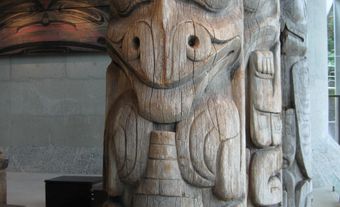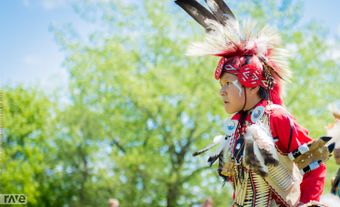What’s a Tipi?
A tipi (also spelled teepee) is a type of shelter, shaped like a cone and traditionally made from wooden poles and coverings sewn from the hides of bison. Tipis were important to the Indigenous peoples of the Plains because they travelled often — to hunt, join social gatherings (such as Sun Dances) or find winter shelter — and therefore needed homes that could be taken down easily and just as easily resurrected. The Plains peoples developed a unique portable house-form — the tipi — which was perfectly adapted to their mobile way of life.
DID YOU KNOW?
The precise origins of the Plains tipi are uncertain. However, telltale rings of stones used to hold down the edges of skin tent covers mark the sites of ancient tipi camps dating back at least 5,000 years on the Prairies, and earlier still in regions to the north.
How Were Tipis Made?
Plains Indigenous peoples first transported the tipi poles and coverings to their desired camp location using dogs, and after the late 18th century, horses. Dogs and horses pulled a travois filled with luggage, while the Plains people walked alongside.
Once at the campsite, Plains people built tipis that were about 4–6 m in diameter at the base, and tapered upward to form a smoke hole at the top. Smoke holes were essential to the tipi; without them, the fires built in the middle of the tipi would cause the structure to burn. Flaps supported by external poles sometimes regulated the draft of the smoke hole to improve ventilation and carry off smoke. The frame of the tipi was draped with a sewn cover of bison skins arranged over as many as 20 poles. Stones often held the edges of the skin covers to the ground. The tipi averaged 5–6 m in height, with the entrance commonly facing east because this was the direction of the rising sun and was opposite the prevailing wind. A place of honour for the owner of the tipi or the oldest man was often located opposite the entrance.
On important occasions, encampments (places where many tipis were erected) were organized in a circular form, usually with an opening to the east. Tipis were arranged in a precise order within this circle, band by band and family by family. Occasionally, these subdivisions formed subsidiary circles. Often, painted tipis composed a small inner circle within the core of the overall circle, particularly during major gatherings, such as Sun Dance ceremonies.
Tipis in the 19th century were often large enough to house several family members, and were embellished with embroidered quillwork and paint. Sacred medicine bundles were hung on tripods within the tipi. Women erected and dismantled these dwellings, and they specialized in cutting and sewing the bison hides so that they would fit the conical frame. After the arrival of horses on the Plains, tipis increased in size and their furnishings became more elaborate and decorative because horses could carry far heavier loads than dogs.
Tipi design varied among the Plains peoples, a major difference being the number of primary poles used for the structural frame. The Siksikaitsitapi (Blackfoot Confederacy) and their allies favoured a four-pole system, while the Cree, Ojibwa and Siouan-speaking peoples (Dakota) typically used a three-pole method. The four-pole system resulted in a somewhat more circular form (as opposed to cone-shaped) and required fewer supplemental poles, but was less stable than the three-pole form. The affiliations of a particular nation’s encampment were easily identifiable at a distance by variations in profile, the shape of vent flaps and pole lengths.
DID YOU KNOW?
Outside the Plains area and around the western Great Lakes and Plateau region in Canada, a dome-shaped dwelling, called a wigwam in the Algonquian languages, was constructed with bent poles and covered with birch bark, skins or mats (see Architectural History: Indigenous Peoples.)
Tipis and Spirituality
Plains peoples developed powerful symbolic associations between the tipi and the spiritual realm. The tipi floor embodied the earth and the Mother; the lodge cover represented the sky and the Father. The poles connected the earth to the sky and provided trails along which the peoples’ prayers might reach the heavens.
A few tipis — perhaps one in ten among the Siksikaitsitapi — were covered with painted images, which transformed them into sacred lodges associated with specific rituals. The images painted on these tipis reflected the owners’ band or First Nation, and had both literal and cosmological meanings. Border designs at the base embodied the earth and things pertaining to the earth; those painted at the top depicted the sky and the spirit world. Between these two regions lay a zone that represented aspects of this world or another world that the principal occupant (or his direct ancestor) entered during a vision. Images in this area consequently ranged from depictions of human exploits to evocations of supernatural creatures that conveyed powers to the first owner of the vision. After the skins wore out, usually every year or two, they were replaced. The paintings on the old tipi cover would be transferred to the new one, and so the designs passed on from generation to generation.
Tipis Then and Now
With the onset of European immigration, and the loss of the bison herds in the second half of the 19th century, the traditional ways of life of the Plains Indigenous peoples ended. They managed to cope for a while, altering their diet and substituting canvas for bison hides for tipi covers, but they were eventually forced onto defined reserves by the federal government. Gradually, the tipi gave way to imposed architectural forms associated with a sedentary (non-mobile) existence.
However, tipis remain important to Indigenous culture. In some cases, tipis are still used to hold spiritual and cultural functions. Some hunters might also use tipi-like structures during their travels. Symbols of Indigenous identity, tipis can also be found as parts of art installations or at sites where Indigenous peoples unite to defend their rights and lands.

 Share on Facebook
Share on Facebook Share on X
Share on X Share by Email
Share by Email Share on Google Classroom
Share on Google Classroom








